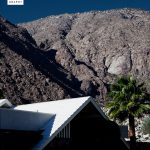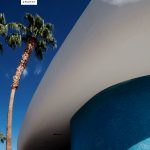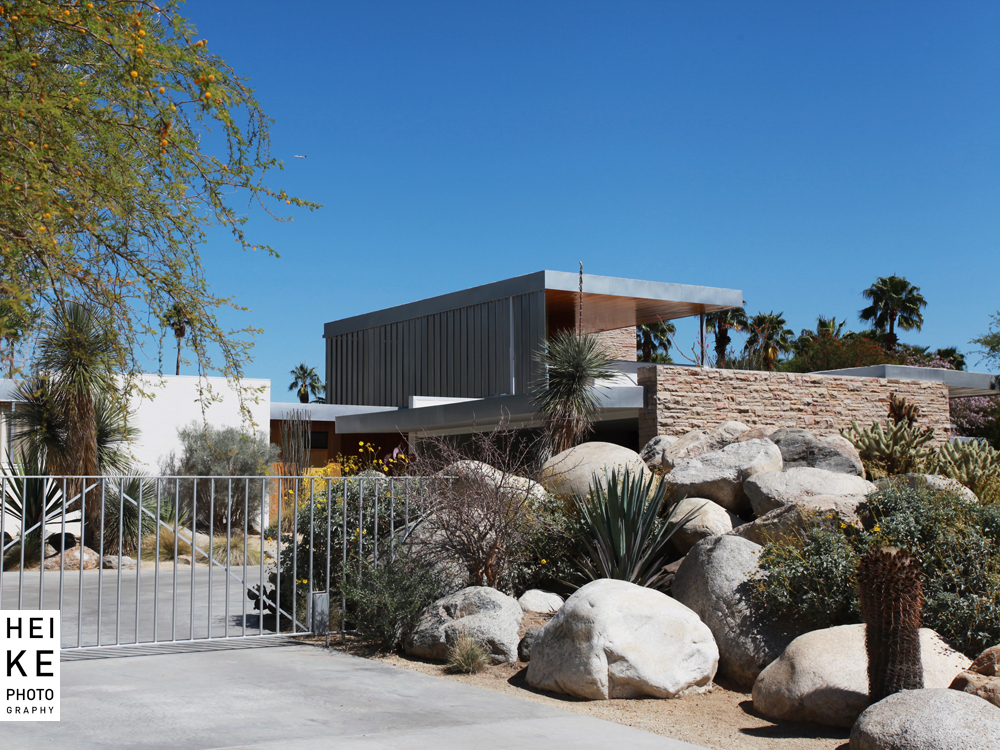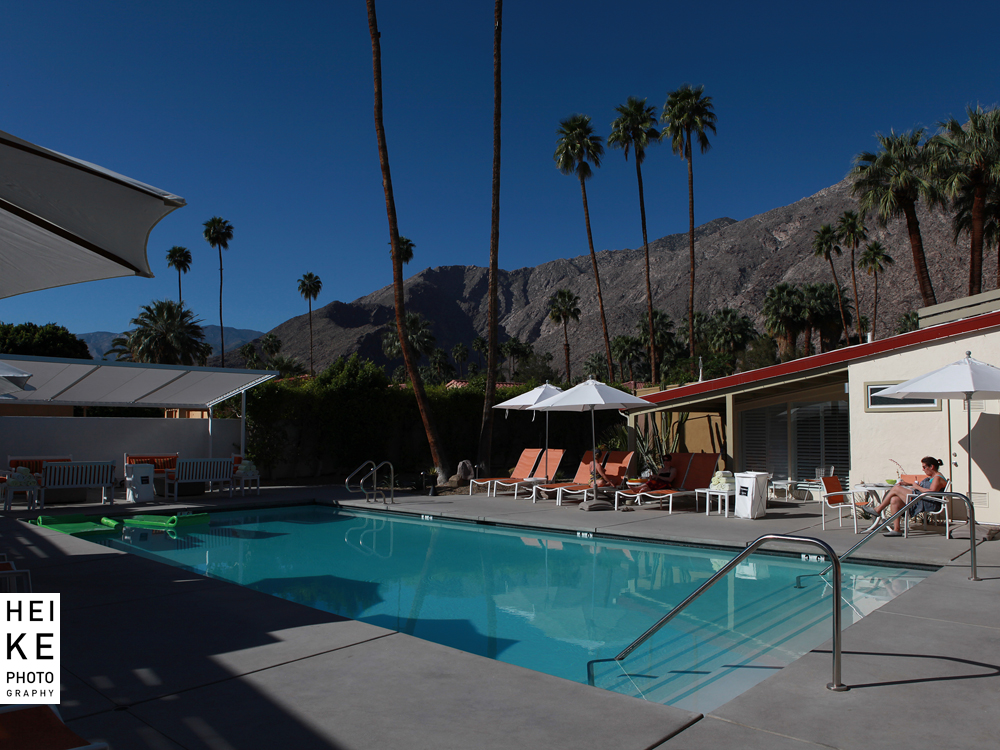Desert Modernism and hanging out with the Rat Pack
[Published in the Independent Newspaper http://ind.pn/1JkZBkq]
The rich and famous have long been in love with Palm Springs. According to the so-called ‘2 hour rule’ actors under contract with a Hollywood studio had to be available within 2 hours, and nearby Palm Springs, with more than 350 days of sunshine per year, was the ideal place to go to for a quick escape. Their glamour made Palm Springs fashionable and attracted visitors from all over the world.
It is a far cry from Palm Springs’ more humble origins as a tuberculosis sanatorium. In 1909 a female entrepreneur named Nellie Coffman started the first hotel, a small health resort hotel called the Desert Inn. During an earlier stay in Palm Springs she had noticed the benefits of desert air and decided with her husband, a doctor, to open their own health resort. At the time Palm Springs had just suffered a devastating drought and was home to only about 60 people. Amongst her first guests were 2 journalists from the LA Times who extolled the virtues of Palm Springs – and the rest as they say, is history. At the time, guests recall being able to walk the entire town in ten minutes.
With the striking desert and mountain backdrop, and along with the endless good weather, it wasn’t long before the studios started to use Palm Springs as a film location. Early celebrity visitors stayed at the Desert Inn, but that changed in 1927 when El Mirador hotel opened. With 165 rooms and a 75 foot pool, it was the first large hotel in Palm Springs to attract Hollywood’s elite. Its long list of celebrity guests include Johnny Weissmuller, Esther Williams, Charlie Chaplin, Shirley Temple, Albert Einstein, Salvador Dali and H.G. Wells. Film stars soon started to build second homes in Palm Springs, and even today a neighbourhood called the Movie Colony is also referred to as “behind El Mirador”.
The second world war put a temporary stop to this, and during this period Palm Springs became an army hospital. With the rising population and affluence of the 1950s came the need for affordable housing and a demand for second homes. Whilst for their first home, wealthy homeowners would mostly choose a traditional style, for their second home they chose a clean, modern design with new materials such as stone, steel, glass, and concrete. Many government buildings, the airport, city hall, banks and businesses were now also built in this new style.
Inspired by the stark desert landscape and modern schools like Bauhaus and the International Style, the architects of the 1950s created in Palm Springs what is now called Desert Modernism. Richard Neutra, Donald Wexler, Albert Frey, William F. Cody, William Krisel, Dan Palmer, Rudolph Schindler and E. Stewart Williams have all worked here. Together they created in the Palm Springs area what is today the highest concentration of mid-century modern architecture in the world.
Donald Wexler steel-frame house in the movie colony.
The ‘Alexander’ house marked the first mass production of Desert Modernism homes. Named after the Alexander Construction Company, the construction of these homes almost doubled the housing capacity of Palm Springs. More than 2000 Alexander houses were built over a 10 year period. In 1957 Twin Palms Estates, a neighbourhood in the then unfashionable south of Palm Springs became the first development. Named Twin Palms because every house featured two palms, starter houses measured 1,200 square feet and included a swimming pool. Priced moderately at $19,500, they were met with great enthusiasm. Later, when the ‘Alexander’ style was adapted to more affluent areas, houses exceeded 2,000 square feet. At the time it was a radical concept, initially developed by architects Krisel and Palmer with the Alexander company: to build stylish and elegant homes with clean, modern lines that were affordable and efficiently producible.
These new developments brought a different class of homeowner to Palm Springs — upper middle class, as opposed to the very wealthy, which it was in the pre-war years. The houses with open floor plans have large windows that allow indoor and outdoor spaces to interact, exposed wood beam ceilings and distinctive rooflines which can be flat, slanted or butterflied, to give each house a unique design.
Twin Palms today is a handsome, quiet neighbourhood which appears surprisingly green in the midst of the California drought. An underground aquifer created from a freshwater lake that covered the Coachella valley in the last ice age, means that palm trees are native to Palm Springs, unlike in Miami or Los Angeles. Because of this, Palm Springs is not quite as affected by the drought, but, as elsewhere in California, homeowners are encouraged to replace water-hungry grass and other plants.
Wandering through the streets of Twin Palms, ocotillo blossoms, chollo and barrel cactuses add colour and shape. Properties here are exquisitely renovated and show a variety of ‘Alexander’ designs. In a way, it is a return to the landscape ideas of the original architects with either native plants that do not require much water, or natural design elements like pebbles and rocks. Interiors are often decorated with classic mid-century or Bauhaus furniture, and along with the rediscovered appreciation of mid-century architecture, vintage cars are very popular.
5 images above: Twin Palms, ‘Alexander’ developments.
It was not always like that. In fact the 70s and 80s were a terrible time for historic architecture. As architect Donald Wexler, who continues to live in the Movie Colony recalls: “I would sometimes drive down the street and spontaneously burst into tears, upon seeing what had been done to the buildings.” Some architecture is listed on the National Registry, but mostly it is up to the owners to maintain their original style. Some hotels were converted to country lodges complete with carpeting and antlers.
In the 40s and 50s affluent Vista Las Palmas became another neighbourhood of choice with spectacular architecture, including the famous and immaculately maintained Kaufmann Desert House, built by Richard Neutra in 1946. The Kaufmann family also owned Fallingwater in Pennsylvania by Frank Lloyd Wright, but for their second home they chose the more modern style of Neutra.
‘Kaufmann Desert House’ by Richard Neutra, 1946.
Many film stars built second homes in Palm Springs and became part of the cultural community. Dinah Shore, Marilyn Monroe, Dean Martin and Joan Collins each owned an “Alexander.” Bob Hope, Frank Sinatra, and Kirk Douglas were amongst the celebrities who had a continued presence here. The difference to other places was, that in Palm Springs they became very involved in the community. Kirk’s wife Anne served on the museum’s board of directors for many years and attended Palm Springs City Council meetings. Frank Sinatra, whose home was designed by E Stewart Williams and is now available to rent (complete with recording studio), would regularly perform for the annual Police Show. His daughter Nancy still lives in the neighbourhood.
Palm Springs has a pleasant small town feel about it and as architecture guide and writer Michael Stern puts it: ‘I lived in New York for years and didn’t know my next door neighbour, when I moved to Palm Springs I knew my entire street within a week.’
Elvis spent his 1966 honeymoon at the Alexander Residence designed by William Krisler called the ‘House of Tomorrow’. During research for one of his books, Michael asked Priscilla Presley why they had chosen this location. She answered “Elvis just loved the architecture”. Another remarkable house near Vista Las Palmas is the Frank Lloyd Wright inspired Edris House, designed by E. Stewart Williams. Built in 1953, it appears to grow organically from its natural surroundings. The Palevsky Residence, built by Craig Ellwood in 1968, shows influences of Le Corbusier. Around every corner seems to be yet another mid-century beauty. It is an intriguing place to wander around for a few hours and do a bit of architectural window shopping.
Above:’Edris House’ by E. Stewart Williams, 1953.
Above:’Palevsky Residence’ by Craig Ellwood, 1968.
Since 1915, when the first movie ‘Lone Star Rush’ was filmed in Palm Springs, it has continued to feature as a movie location. ‘Ocean’s Eleven’ was partly filmed in Old Las Palmas, as was recently ‘Behind The Candelabra’. In 2014, 123 film permits were issued. As former mayor Ron Oden says, “We’ve always known that Hollywood comes here to relax and play, but it’s pretty obvious that they come here for work too!”
Palm Springs continues to attract modern day Hollywood. Architecture loving Leonardo DiCaprio recently bought the Dinah Shore Residence, built in 1964 by Donald Wexler. The house can be rented for a mere $4500 dollars per night, which gets you six bedrooms and 7.5 bathrooms, a swimming pool, tennis courts and a guest casita.
For a more affordable experience of mid-century living you can also stay in one of the cities restored hotels. The Del Marcos Hotel is a 17 room mid-century property designed by William F. Cody, centered around a pool pitched against the spectacular backdrop of the San Jacinto mountains. 50s tunes played at the pool give the place a very laid-back feel, and according to hotel rules no loud telephone conversations are allowed poolside, which has to be one of the best hotel rules ever. Mid-century furniture makes a welcome change from identikit hotel lounges. The hotel has been restored with great care; in fact most of the mid-century houses in Palm Springs have turned into a labour of love for their new owners. Whilst it is easy to dismiss the 50s retro trend as just another fashion fad, it feels like time-travel to see them returned to former, and sometimes even improved, beauty; making Palm Springs almost a museum of mid-century modern architecture.
‘Del Marcos Hotel’ by William F. Cody, 1947
When Lars, the owner of the Del Marcos, bought the hotel 12 years ago it had been neglected like so many other properties of that time. As he says, “It’s been a long process and has been an incredible amount of work. But then we won an award for the restoration, we met William F. Cody’s the family and architect Donald Wexler, and they thanked us for preserving the vision that they had. I bought this property as an investment 12 years ago, but it’s my baby now, and I don’t think I can ever sell it”.
Travel Essentials:
VIEW The Palm Springs Aerial Tram climbs 6000 vertical feet and is described as the climate equivalent of a ‘drive from Mexico to Alaska’. Touristy, but the view from the top is amazing. Get there early to avoid crowds.
WALK The San Jacinto mountains offer plenty of hiking trails, nearby Palm Canyon is a quick escape from the city; The Living Desert on the outskirts of Palm Springs is a more leasurely way to explore desert flora and fauna.
SOAK Nearby Desert Hot Springs known for natural, healing, hot mineral water offers a variety of spa treatments for every budget.
EAT Palm Canyon Drive is lined with restaurants, head for Copley’s at the northern end to eat at Cary Grant’s former guest house; or hang out at one of the bars frequented by the rat pack, like Melvyn’s.
SEE The Palm Springs Art Museum has excellent exhibitions and the Architecture and Design Center is housed in the historic Edwards Harris Pavilion, built by E. Stewart Williams in 1960.
Rooms at Hotel Del Marcos start from USD 229 (approximately £154) per night, based on accommodation in the Chi Chi Room on a room-only basis www.delmarcoshotel.com.
Michael Stern’s Modern Tour offers knowledgable insight into the architectural history of Palm Springs http://www.themoderntour.com/
For more information on visiting Palm Springs, please see www.visitpalmsprings.com.
Text and images ©2015 Heike Bohnstengel






































